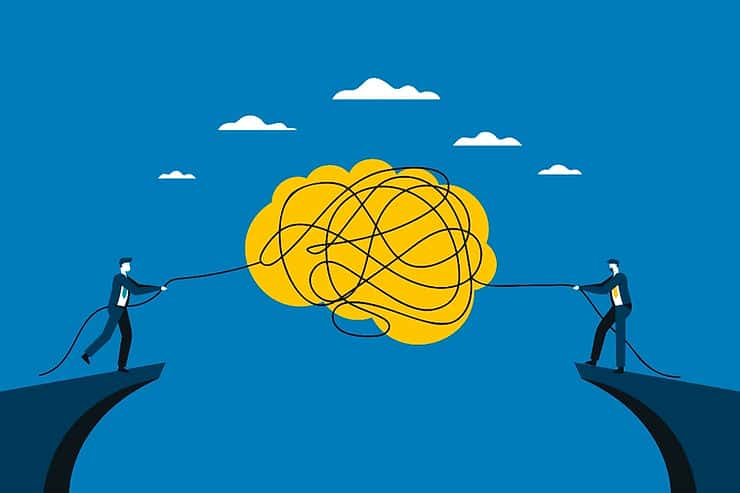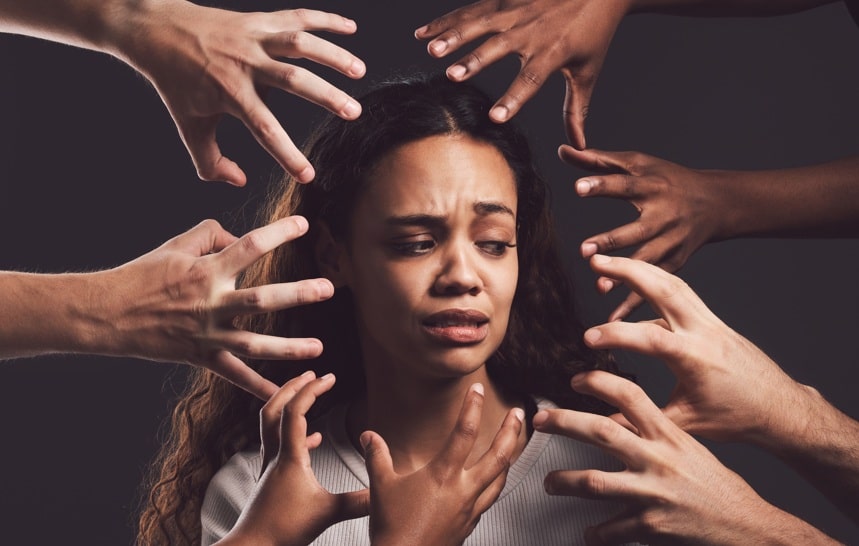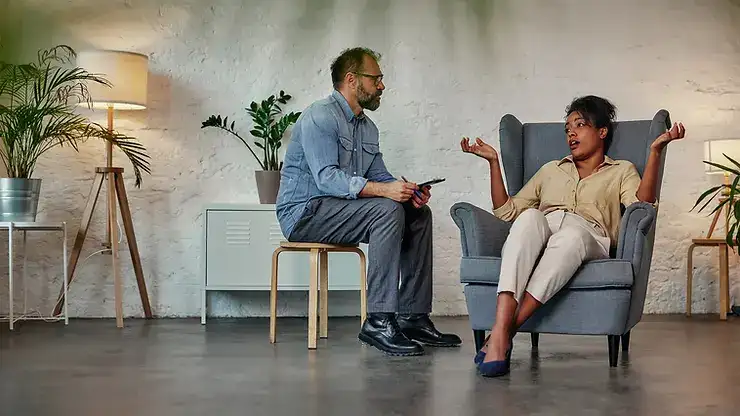Do you ever feel like your mind is a web browser with countless tabs open, particularly when anxiety kicks in? At Wholesome Mind Psychiatry, we perceive this whirlwind of thoughts not as a hindrance but as a hidden wellspring of creativity.
Anxiety, frequently approached with a sense of discomfort and seen as a challenge, can indeed act as a spark for the creative flame that resides within each of us. Straton a journey with us as we explore how the hum of anxiety, a shared experience for many, can unexpectedly become a driving force for creativity. It’s about transforming those overpowering thoughts into groundbreaking ideas and unique artistic expressions.
here you will know about The Connection Between Anxiety and Creativity
On this page:
here you will learn about The Connection Between Anxiety and Creativity
1. Unveiling the Connection
The relationship between anxiety and creativity isn’t just a fleeting observation; it’s a profound connection that dives deep into the workings of our minds. When anxiety kicks in, it’s like our brain shifts into overdrive, becoming hyper-aware of our surroundings and more sensitive to stimuli. This heightened state can lead to an unexpected silver lining: a boost in creative thinking and problem-solving abilities.
Brainstorming on Hyperdrive: Anxiety often leads to a state of heightened awareness. In this state, you’re more likely to notice details you might overlook otherwise, providing rich material for creative endeavors.
Increased sensitivity to your environment can feed your imagination, offering new angles and ideas for creative projects.
An anxious mind tends to think more about “what ifs,” which can be a potent tool for brainstorming and innovative thinking.
Emotional Depth: The intense emotions associated with anxiety can deepen your empathy and understanding of human experiences, enriching your creative work.
Harnessing these emotions can lead to more profound, relatable art, writing, or music.
Anxiety can push you to explore themes of struggle, resilience, and the human condition, resonating deeply with others.
The Creativity-Anxiety Cycle: Engaging in creative activities can, in turn, influence your anxiety levels. Creativity offers an outlet for expression, potentially easing anxiety while using its energy as fuel.
Creative pursuits can act as a distraction, allowing you to take a break from anxious thoughts and focus on the task at hand.
The sense of accomplishment from completing a creative project can boost your mood and self-esteem, countering feelings of anxiety.
Understanding the link between anxiety and creativity offers a new perspective on how to view and manage our anxious thoughts. Rather than seeing them solely as a hindrance, we can learn to embrace them as a catalyst for creativity, turning our inner turmoil into a source of strength and inspiration.
2. Anxiety: The Unexpected Muse
Anxiety, often seen as a disruptive force, can unexpectedly play the role of a muse, pushing the boundaries of creativity and innovation. This intriguing dynamic sheds light on how a state of discomfort can lead to extraordinary artistic and intellectual breakthroughs. By embracing anxiety as a catalyst rather than a barrier, individuals can unlock a wellspring of creativity that might otherwise remain untapped.
Historical Inspiration: Many renowned artists, writers, and thinkers have channeled their anxiety into groundbreaking works. This historical precedent serves as a testament to the powerful connection between anxiety and creativity.
The restlessness associated with anxiety can motivate individuals to engage in creative pursuits as a form of expression and catharsis.
The intensity of emotions felt during anxious episodes can lead to a deeper exploration of themes, adding richness and authenticity to creative works.
A New Perspective on Challenges: Viewing anxiety as a muse involves reinterpreting challenges as opportunities for growth and creativity, transforming the way we approach both our art and our mental health.
Challenges posed by anxiety can become sources of inspiration, encouraging a deeper inquiry into personal experiences and societal issues.
This perspective shift can foster resilience, as individuals learn to navigate their anxiety with creativity and purpose, leading to personal and artistic growth.
3. Creative Outlets as Therapy
Creative outlets offer a therapeutic path through the tangled woods of anxiety, serving as both an escape and a method of confrontation. Engaging in creative activities provides a unique way to process and express emotions that are often difficult to articulate. This therapeutic approach can lead to a deeper understanding of oneself and one’s anxiety, transforming creative expression into a powerful tool for emotional healing and personal growth.
Art as a Safe Space: Creative activities create a safe space for emotional exploration, allowing individuals to express their feelings without fear of judgment or misunderstanding.
Artistic expression can serve as a non-verbal language for emotions, providing relief in conveying what words cannot.
The act of creating can become a meditative process, offering a sense of calm and focus in the midst of anxiety.
Creating playlists for different moods can help manage anxiety, using music as a tool to uplift, soothe, or energize.
The repetitive motions involved in crafts can be soothing, creating a rhythm that helps calm the mind.
Completing a project provides a tangible result of effort, boosting self-esteem and combatting feelings of ineffectiveness that often accompany anxiety.
Through creative outlets, individuals find not only a therapeutic tool for managing anxiety but also a pathway to rediscovering joy, purpose, and self-expression. By integrating these practices into daily life, people can build a repertoire of coping strategies that harness the healing power of creativity, turning their anxious energy into a source of strength and inspiration.
4. Turning Anxiety into Art
The transformation of anxiety into art is a powerful alchemy, where the leaden weight of worry is transmuted into golden threads of creativity. This process not only provides an outlet for expressing anxiety but also reframes it as a resource for artistic inspiration. By channeling anxious energy into creative endeavors, individuals can find a sense of purpose and achievement, transforming their relationship with anxiety.
Personal Narratives: Sharing personal stories of anxiety through art can be cathartic for both the creator and the audience, fostering a sense of connection and understanding.
Art that stems from personal anxiety experiences can resonate deeply with others, breaking down feelings of isolation.
Creating narratives around anxiety helps to externalize and examine it, reducing its overwhelming power.
Visualizing Anxiety: Visual arts like painting, drawing, or sculpture can capture the abstract and often indescribable nature of anxiety, giving it form and color.
Experiment with different mediums to visually express the sensations and emotions associated with anxiety.
Abstract art can particularly mirror the chaotic nature of anxious thoughts, allowing for a creative release of pent-up feelings.
Movement and Dance: Using the body as a canvas, dance and movement therapies can physically manifest anxiety, offering a unique method for exploration and expression.
Movement allows for the physical release of anxious energy, channeling it into expressive and therapeutic routines.
Participating in dance can increase body awareness and control, countering feelings of helplessness that often accompany anxiety.
Photography as Reflection: Capturing images that evoke or relate to your anxiety can help in acknowledging and understanding these feelings from a new perspective.
Photography can serve as a tool for mindfulness, focusing on the present moment and finding beauty in the world around you.
Creating visual metaphors for anxiety through photography can aid in conveying complex emotions to others, promoting empathy and connection.
Turning anxiety into art is not just about creating beautiful or thought-provoking pieces; it’s about redefining the experience of anxiety itself. Through artistic expression, individuals can navigate their inner turmoil, finding peace and purpose in the process. This creative journey offers a path to healing, where anxiety becomes not just manageable but a vital part of the creative tapestry of life.
5. Managing the Balance
Mastering the balance between harnessing anxiety for creative purposes and preventing it from becoming overwhelming is akin to walking a tightrope. It requires mindfulness, self-awareness, and proactive strategies to ensure that anxiety fuels creativity without consuming it. This delicate equilibrium allows individuals to use their anxiety as a source of inspiration while maintaining their mental health and well-being.
Setting Boundaries: It’s crucial to recognize when to step back and take a break, understanding that constant engagement with anxiety can be draining.
Establish clear boundaries between work and relaxation to ensure anxiety doesn’t infiltrate every aspect of life.
Learn to say no to additional stressors that might tip the balance unfavorably.
Structured Creativity: Implementing a routine for creative work can help channel anxious energy productively, providing structure and predictability.
Designate specific times for creative pursuits, allowing for a regular outlet for anxious energy.
Use timers or schedule blocks of time for work and breaks to avoid burnout.
Mindfulness Practices: Integrating mindfulness and meditation into daily life can help manage anxiety levels, fostering a calmer state of mind conducive to creativity.
Practice mindfulness exercises to stay present and reduce worrying about the past or future.
Meditation apps or guided sessions can provide structure for beginners.
Physical Wellness: Maintaining physical health through exercise, diet, and sleep is foundational to managing anxiety and supporting creative energy.
Regular physical activity can alleviate symptoms of anxiety and boost mood.
A balanced diet and sufficient sleep are critical for cognitive function and emotional regulation.
Seek Support: Engaging with a community of creatives who understand the challenges of balancing anxiety and creativity can provide invaluable support.
Join online forums or local groups where experiences and strategies for managing anxiety and creativity are shared.
Consider therapy or counseling as a resource for learning personalized strategies to balance anxiety.
Managing the balance between anxiety and creativity involves a combination of personal strategies, lifestyle adjustments, and support systems. By acknowledging anxiety’s role in the creative process and actively managing its impact, individuals can harness its energy positively, leading to a fulfilling and sustainable creative life.
6. Embracing Your Creative Anxiety
Embracing your creative anxiety is about shifting your perspective to view this internal tumult not as an adversary but as a source of strength and inspiration. It involves acknowledging the energy and potential that anxiety brings to the creative process and learning to navigate it with grace and resilience. This positive reframe can transform the experience of anxiety from one of struggle to one of empowerment, where each anxious thought holds the possibility of a new creation.
Cultivating a Positive Mindset: Begin by changing the narrative around anxiety, viewing it as a catalyst for creativity rather than an obstacle.
Recognize and celebrate the unique perspectives and ideas that arise from anxious thoughts.
Practice gratitude for the sensitivity and depth that anxiety adds to your creative work.
Harnessing Anxiety as a Creative Force: Learn to channel the energy and urgency of anxiety into your creative endeavors, using it to propel your projects forward.
Use anxious moments as triggers for brainstorming sessions, where the heightened state can lead to breakthrough ideas.
Allow the intensity of your feelings to deepen the emotional impact of your art, making it more relatable and powerful.
Sharing Your Journey: Open up about your experiences with creative anxiety through your work or in conversations, helping to destigmatize anxiety and inspire others
Blog, vlog, or use social media to share your process and how anxiety influences your creativity, creating a sense of community and support.
Offer workshops or talks on embracing creative anxiety, providing strategies and encouragement to others facing similar challenges.
Self-Compassion and Patience: Treat yourself with kindness and understand that navigating creative anxiety is a journey, with ups and downs.
Acknowledge your progress and the effort it takes to channel anxiety into creativity, rather than focusing solely on outcomes.
Be patient with yourself during periods of high anxiety, recognizing that sometimes, taking a step back is part of the process.
In conclusion, the dance between anxiety and creativity is a complex but deeply interconnected one. By acknowledging and channeling your anxious energy into creative outlets, you not only manage your anxiety better but also unlock a wellspring of innovation and expression. So next time anxiety knocks, consider inviting it to the canvas, the keyboard, or whatever medium speaks to you, and let the transformation begin.
Wholesome Mind Psychiatry is Ready to Help
At Wholesome Mind Psychiatry, we’re all about supporting you in recognizing when it’s time to seek out a pro. You’ve got this, and we’ve got you.



